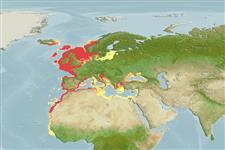Common names from other countries
Environment: milieu / climate zone / depth range / distribution range
Écologie
marin démersal; profondeur 20 - 318 m (Ref. 56504). Subtropical; 8°C - 24°C (Ref. 4944); 66°N - 9°N, 18°W - 42°E
Eastern Atlantic: Norway to Cape Blanc (along the African coast); not recorded at Madeira and the Azores. Also in the Mediterranean and Black seas.
Length at first maturity / Taille / Poids / Âge
Maturity: Lm 24.7 range ? - ? cm
Max length : 82.8 cm TL mâle / non sexé; (Ref. 113018); common length : 30.0 cm TL mâle / non sexé; (Ref. 3397); poids max. publié: 6.6 kg (Ref. 113018); âge max. reporté: 15 années (Ref. 26811)
Longest ray in the pectoral fin reaching the front part of the anal fin. Lateral line scales smooth. Reddish color (Ref. 35388).
Occurs at temperatures ranging from 8.0-24.0 °C (Ref. 4944). Inhabits sand, muddy sand or gravel bottoms. Up to depth of 318 m in the eastern Ionian Sea (Ref. 56504). Feeds on fish, crustaceans and mollusks. Has three isolated rays on the pectoral fin which function as legs on which the fish rests and also help in locating food on the soft bottom (Ref. 9988). Marketed fresh or frozen; eaten pan-fried, broiled, microwaved or baked (Ref. 9988).
Distinct pairing during breeding (Ref. 205).
Richards, W.J. and V.P. Saksena, 1990. Triglidae. p. 680-684. In J.C. Quero, J.C. Hureau, C. Karrer, A. Post and L. Saldanha (eds.) Check-list of the fishes of the eastern tropical Atlantic (CLOFETA). JNICT, Lisbon; SEI, Paris; and UNESCO, Paris. Vol. 2. (Ref. 3687)
Statut dans la liste rouge de l'IUCN (Ref. 130435)
CITES (Ref. 128078)
Not Evaluated
Menace pour l'homme
Harmless
Utilisations par l'homme
Pêcheries: commercial; pêche sportive: oui; Aquarium: Aquariums publics
Outils
Articles particuliers
Télécharger en XML
Sources Internet
Estimates based on models
Preferred temperature (Ref.
115969): 7 - 16, mean 9.8 (based on 453 cells).
Phylogenetic diversity index (Ref.
82804): PD
50 = 0.5010 [Uniqueness, from 0.5 = low to 2.0 = high].
Bayesian length-weight: a=0.00776 (0.00657 - 0.00916), b=3.03 (2.98 - 3.08), in cm Total Length, based on LWR estimates for this species (Ref.
93245).
Niveau trophique (Ref.
69278): 4.0 ±0.0 se; based on diet studies.
Résilience (Ref.
120179): Faible, temps minimum de doublement de population : 4,5 à 14 années (K=0.15-1.6(?); tmax=14; tm=3).
Fishing Vulnerability (Ref.
59153): Moderate to high vulnerability (55 of 100).
Climate Vulnerability (Ref.
125649): Moderate vulnerability (38 of 100).
